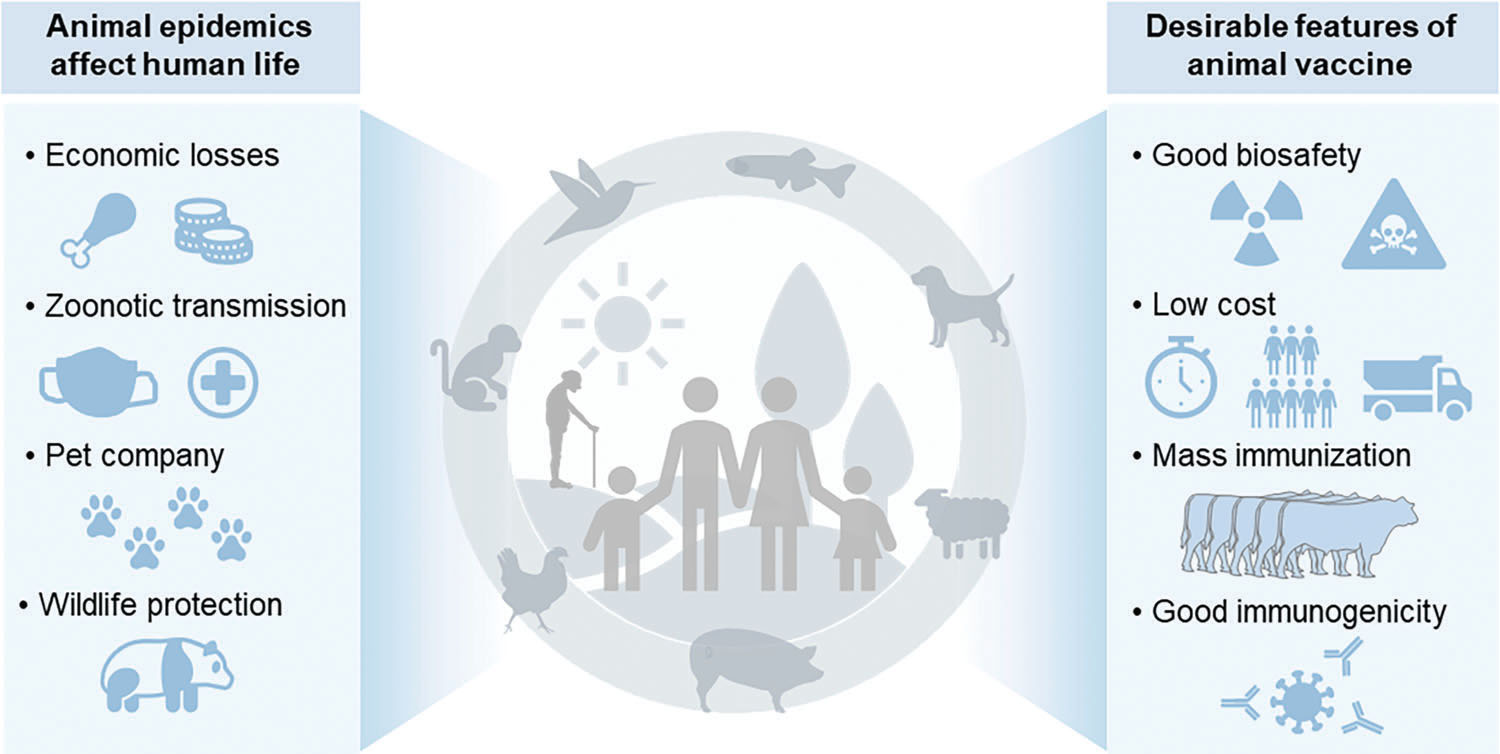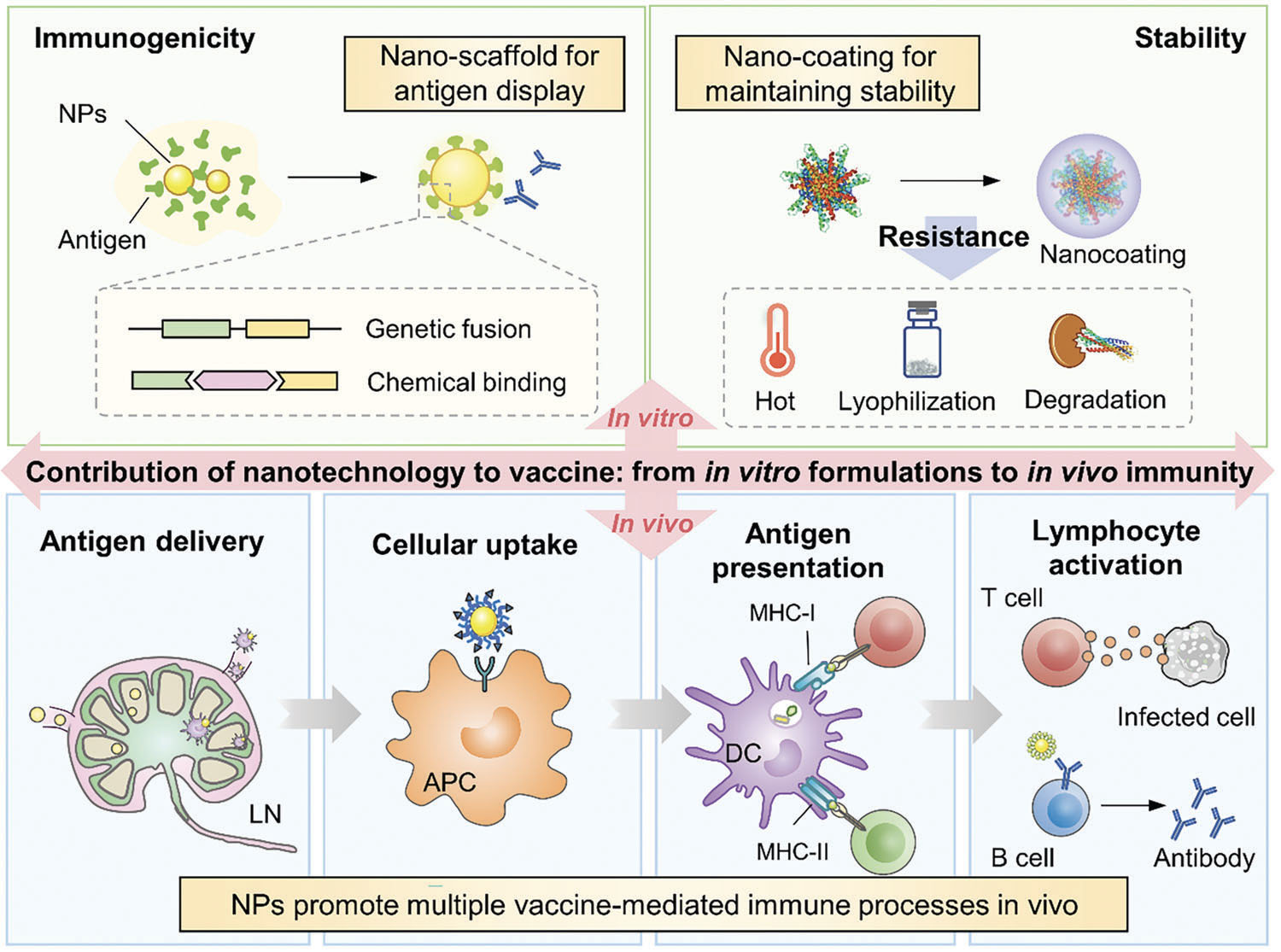| Jul 20, 2023 | |
Nanotechnology fuels next wave of vaccine development for animal health |
|
| (Nanowerk Spotlight) Preventing animal epidemics is of paramount importance because they can directly impact food and nutritional safety, the economy, and can lead to outbreaks of zoonotic diseases that pose a threat to human health. The spread of infectious diseases in animals causes significant economic losses for the cultivation industry. For instance, the outbreak of highly pathogenic avian influenza from 2014 to 2015 affected approximately 50 million poultry, leading to a loss of nearly US$ 3.3 billion to the United States economy. | |
| These epidemics can also significantly reduce the availability of animal products such as meat, milk, and eggs, which are key sources of protein and other essential nutrients for humans. For example, the outbreak of African Swine Fever in China in 2018 led to the culling of millions of pigs, causing a significant shortage in pork supply, a staple in the Chinese diet. | |
| Moreover, some animal infections are zoonotic and can be transmitted to humans, accounting for over 60% of human infectious diseases and posing a considerable threat to global health. These diseases can lead to serious public health crises. For instance, the H1N1 influenza pandemic in 2009, which originated from pigs, resulted in hundreds of thousands of human deaths worldwide. More recently, the COVID-19 pandemic, believed to have originated from wildlife, has caused millions of deaths globally, highlighting the potential of animal diseases to jump to humans and cause widespread illness. | |
| Furthermore, animal epidemics can have devastating effects on wildlife populations and biodiversity. Diseases can spread rapidly among wild animals, leading to mass mortality events that can affect ecosystem balance. For example, the white-nose syndrome in bats, caused by a fungus, has led to the death of millions of bats in North America, raising concerns about the potential impacts on insect populations that bats help control. | |
 |
|
| Schematic diagram of the relationship between animal epidemics, animal vaccines, and human health and wellness. Animal epidemics affect human livelihood, mainly through economic losses, zoonotic transmission, companion pet health, and wildlife protection. Therefore, the prevention and control of the spread of animal epidemics cannot be ignored. As one of the most cost-effective ways to combat animal epidemics, an ideal animal vaccine should possess the features of good biosafety, low cost, suitability for mass vaccination, and good immunogenicity. (Reprinted with permission from Wiley-VCH Verlag) | |
Limitations of Traditional Vaccines and Adjuvants |
|
| Traditional vaccines and adjuvants, while crucial in disease prevention, have their limitations. Inactivated vaccines often have poor immunogenicity and require repeated vaccinations, whereas live-attenuated vaccines pose a risk of pathogenic reversion. Subunit vaccines, developed to improve vaccine safety and tolerability, are less immunogenic than the whole pathogen. | |
| Nucleic acid vaccines, a new generation of vaccines, have been widely studied due to their safety, reproducible large-scale production, and the ability to induce humoral and cellular immune responses. However, the inefficient delivery and low transfection efficiency of naked nucleic acid pose a challenge to the development of these vaccines. | |
| In the face of increasing epidemics and the urgent need for effective prevention strategies, a recent scientific review paper in Advanced Functional Materials ("Advances of Nanotechnology Toward Vaccine Development Against Animal Infectious Diseases") offers a fresh perspective. The authors delve into the potential of nanotechnology in the development of vaccines for animal infectious diseases, emphasizing its role in overcoming the limitations of traditional vaccines and adjuvants. | |
The Role of Nanotechnology in Vaccine Development |
|
| Nanotechnology has emerged as a revolutionary tool in vaccine development, offering unique physicochemical characteristics that provide new prospects for animal vaccine development. Various nanoparticles (NPs) have been developed to circumvent the limitations of traditional vaccines and adjuvants, offering more benefits and broad application potential in animal vaccine development. | |
| At the in vitro formulation level, nanoparticles enhance the immunogenicity and stability of antigens. They provide a scaffold for the repetitive display of antigens, allowing multiple copies of antigens to be distributed on the surface in a highly ordered manner. This facilitates the maintenance of antigen conformation and provides superior immunogenicity. The insertion of cobalt porphyrin-phospholipid (CoPoP) into the lipid bilayer, for instance, enables polyhistidine-tagged recombinant antigens to be anchored on the surface of liposomes, enhancing the immunogenicity of the vaccine. | |
| Nanoparticles also play a crucial role in enhancing the stability of vaccines. They protect antigens from enzymatic degradation, help them cross various biological barriers, and enhance the in vitro stability of vaccines. This breaks the dependence on the cold chain, prolongs the storage period, and reduces the antigen dosage, greatly reducing the cost of preparation, storage, and transportation. | |
| In addition to enhancing immunogenicity and stability, nanoparticles can also be used as adjuvants. They can be loaded with immunostimulatory adjuvants, such as toll-like receptor (TLR) agonists and cytokines, to enhance adjuvant delivery efficiency and activity. Compared with traditional adjuvants, nanoparticle-based adjuvants provide more benefits and have broad application potential in animal vaccine development. | |
| At the in vivo immunity level, nanoparticles facilitate the key stages in the immune process from the start of vaccination of different routes to the eventual induction of the immune response. They facilitate antigen delivery, cellular uptake, antigen presentation, and lymphocyte activation, contributing to a more robust and effective immune response. | |
| However, the authors also highlight the need for further research on the distribution and metabolic behavior of nanoparticles after vaccination via different routes. The impact of nanomaterial degradation on the stability of vaccines also needs to be studied further. Despite these challenges, the rational design of vaccine formulations based on nanotechnology offers the possibility of maintaining antigen conformation, providing long-term protection, and resisting viral mutations. | |
 |
|
| Contribution of nanotechnology to vaccine from in vitro formulations to in vivo immunity. At the in vitro formulation level, nanoparticles enhance the immunogenicity and stability of antigens through nano-scaffold and nanocoating strategies. At the in vivo immunity level, nanoparticles facilitate multiple immune response processes, including antigen delivery, cellular uptake, antigen presentation, and lymphocyte activation, showing superior adjuvant activity.NPs, nanoparticles; LN, lymph node; APC, antigen-presenting cell; DC, dendritic cell; MHC-I, major histocompatibility complex I; MHC-II, major histocompatibility complex II. (These figures were created using Servier Medical Art templates (https://smart.servier.com), which are licensed under a Creative Commons Attribution 3.0 Unported License) | |
Biosafety Risks Associated with Nanoparticles Use in Animals |
|
| The authors emphasize that while nanoparticles offer significant advantages in vaccine development, it is crucial to consider and evaluate their potential safety risks. | |
| The toxicity of nanoparticles is mainly determined by their size, composition, synthesis method, and dosage. For instance, gold nanoparticles exert size-dependent toxic effects on cells, including oxidative stress, autophagosome accumulation, and lysosomal impairment. Moreover, naked gold nanoparticles show aggregation and high levels of accumulation in the liver and spleen, where they cannot be metabolized and can induce irreparable toxic effects. To improve the distribution of gold nanoparticles, smaller-sized, GSH-modified gold nanoclusters have been developed. | |
| The authors also highlight the potential developmental toxicity of highly soluble, functionalized single-walled carbon nanotubes (SWCNTs) to newly hatched larvae, emphasizing the need to consider and evaluate the safety of chronic exposure to carbon nanotubes in aquatic environments. | |
| Biodegradation concerns associated with nanoparticles have led to the use of degradable nanoparticles in animal vaccines. Biodegradable polymeric nanoparticles, for example, have attracted widespread attention. However, the authors note that the potential safety risks posed by nanoparticles during animal vaccine development need to be considered. Efforts are being made to develop biocompatible nanoparticles by exploring biodegradable nanomaterials and improving the synthesis process without using toxic solvents. | |
Conclusion |
|
| In conclusion, while there are challenges to be addressed, the potential of nanotechnology in the development of vaccines for animal infectious diseases is immense. With continued research and development, nanotechnology could revolutionize the field of animal vaccine development, offering more effective strategies in combating animal infectious diseases, ultimately contributing to the harmonious coexistence of humans and animals. | |
 By
Michael
Berger
– Michael is author of three books by the Royal Society of Chemistry:
Nano-Society: Pushing the Boundaries of Technology,
Nanotechnology: The Future is Tiny, and
Nanoengineering: The Skills and Tools Making Technology Invisible
Copyright ©
Nanowerk LLC
By
Michael
Berger
– Michael is author of three books by the Royal Society of Chemistry:
Nano-Society: Pushing the Boundaries of Technology,
Nanotechnology: The Future is Tiny, and
Nanoengineering: The Skills and Tools Making Technology Invisible
Copyright ©
Nanowerk LLC
|
|
|
Become a Spotlight guest author! Join our large and growing group of guest contributors. Have you just published a scientific paper or have other exciting developments to share with the nanotechnology community? Here is how to publish on nanowerk.com. |
|
